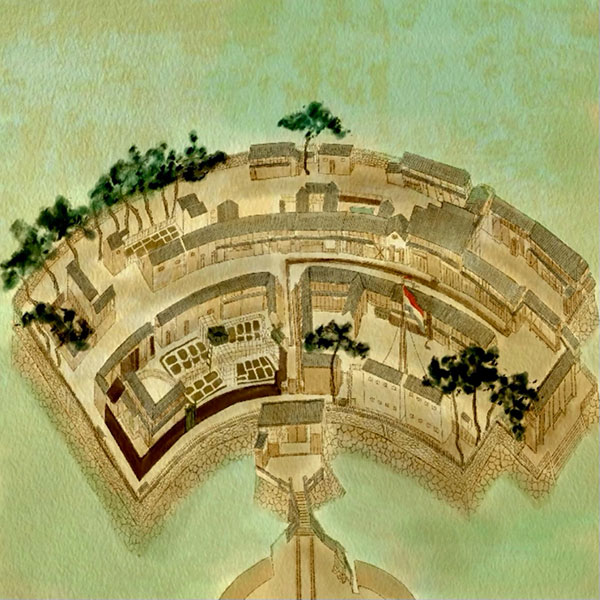National Isolation Order (2/2)"National Isolation" by the Edo Shogunate

National isolation
- Article category
- case file
- Incident name
- National Isolation Order (1633-1639)
- place
- Tokyo
- Related castles, temples and shrines

Edo castle
In 1636, the 13th year of the Kanei era, the "Fourth Isolation Order" was issued, which was a measure against the Catholic country of Portugal. The shogunate exiled 287 Portuguese people who had no connection to trade, along with their wives and children, to Macau, and moved the remaining Portuguese people to Dejima, which was completed in the same year.
As the shogunate gradually restricted trade with overseas countries and intensified its oppression of Christianity, the Shimabara Rebellion broke out in October 1637. The shogunate was driven by a large-scale Christian rebellion that continued until February 1638, and after the rebellion was put down, it felt an even greater sense of crisis toward Christianity.
The road to "national isolation" ④ The fifth isolation order completes "national isolation"
This was followed by the July Order of 1639 (Kan'ei 16), also known as the "Fifth Order of National Isolation," which completely banned Portuguese ships from entering Japanese ports, stating that any ships that violated this order would be destroyed and their crews executed by beheading.
The order also stated that "if Christians band together and plot anything bad, they will be punished immediately," showing the influence of the Shimabara Rebellion. It is said that the fifth isolation order marked the completion of Japan's national isolation.
Incidentally, Japan severed diplomatic relations with Spain, another Catholic country alongside Portugal, in 1624 and banned Spanish ships from arriving in Japan. It is said that the reason that relations with Portugal continued until 1636 was because Japan was waiting until the Protestant country of the Netherlands was able to provide the trade goods that Japan wanted.
The Netherlands fought against Spain in the Dutch War of Independence, and although the United Dutch Republic was established in 1581, the war continued, and it was not until 1609 that a truce was concluded with Spain. In the same year, the Netherlands opened a trading post in Hirado.
As for what happened to Britain, which was one of the major trading nations in the early Edo period, it lost out in competition with the Netherlands, closed its trading post in Hirado in 1623, and withdrew.
Where were the "four entrances" located during the "national isolation" policy?
Although the so-called "national isolation" was completed by the fifth isolation order, there were still four gateways to the outside world: Nagasaki, Satsuma, Tsushima, and Matsumae (Ezo).
At the Nagasaki entrance, trade with the Netherlands and China (Ming and Qing) was conducted under the direct control of the shogunate's Nagasaki Magistrate. These two countries did not have formal diplomatic relations during the Edo period, and were only trade partners, so they are called "trading nations." The Dutch stayed in Dejima, and the Chinese stayed in the city of Nagasaki at first, but from 1689 (Genroku 2), they were required to stay in the Chinese Residence to prevent smuggling and the spread of Christianity via China.
In the Satsuma area, the Shimazu clan of the Satsuma Domain (Kagoshima Prefecture and southwestern Miyazaki Prefecture) conducted diplomatic and trade with the Ryukyu Kingdom, and in the Tsushima area, the So clan of the Tsushima Domain (Tsushima City, Nagasaki Prefecture and part of Saga Prefecture) conducted diplomatic and trade with Korea. Because they had formal diplomatic relations, the two countries are called "communicating countries."
After the Ryukyu Kingdom was invaded by the Shimazu clan in 1609 (Ryukyu Invasion), it was essentially under the control of the Shimazu clan, although it maintained a semi-independent state. Envoys from the Ryukyu Kingdom visited Edo a total of 18 times, starting in 1634 (Kan'ei 11) and ending in 1850 (Kaei 3).
Meanwhile, a total of 12 envoys (the first three had different names) came from Korea between 1607 (Keicho 12) and 1811 (Bunkaku 8). Relations with Korea had deteriorated due to Toyotomi Hideyoshi's military intervention in Korea, but the So clan, who had originally had close ties with Korea, restored diplomatic relations after negotiations.
The last Matsumae entrance was where the Matsumae clan of the Matsumae Domain (initially in southern Hokkaido, then expanded) conducted trade with the Ainu of Ezo (all of Hokkaido, Sakhalin Island, the Kuril Islands, etc.), and ultimately with the residents of the lower reaches of the Heilongjiang River (Amur River) in Russia via the Ainu.
The end of "national isolation" and "opening of the country"
In this way, the shogunate continued to have exchanges with foreign countries while remaining "closed to the country." However, in the latter part of the Edo period, ships from Russia, France, Britain, and America began to visit Japan one after another to negotiate diplomacy and trade. Then, in July 1853 (Kaei 6), the black ships led by Matthew Perry arrived in Uraga. In March 1854 (Kaei 7), the Treaty of Peace and Amity between Japan and the United States was signed, and Japan ended its "closed country" policy and "opened up to the world."
Re-read the article on the National Isolation Order

- WriterNaoko Kurimoto(Writer)I am a former travel industry magazine reporter. I have loved history, both Japanese and world history, since I was a child. I usually enjoy visiting temples and shrines, especially shrines, and often do ``pilgrimages to sacred places'' themed around historical figures. My favorite military commander is Ishida Mitsunari, my favorite castle is Kumamoto Castle, and my favorite castle ruins is Hagi Castle. My heart flutters when I see the ruins of battle castles and the stone walls of castle ruins.



